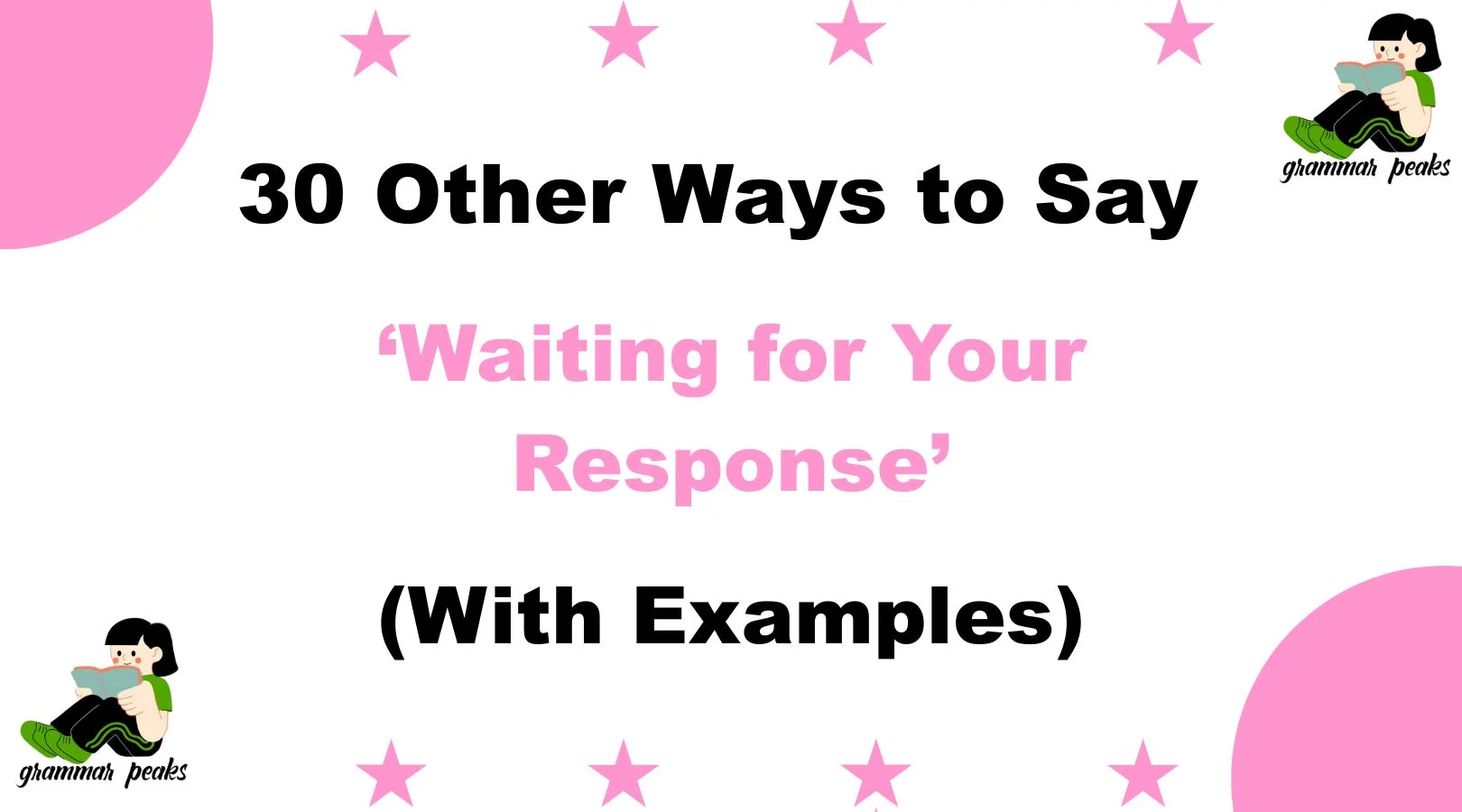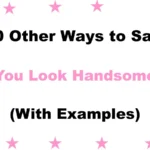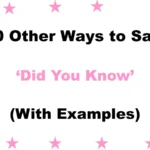Finding the right words to communicate in a thoughtful and respectful way is essential—especially in emails, messages, or professional follow-ups. Saying “Waiting for your response” can sometimes sound too blunt, overly formal, or even impatient. That’s why using alternative phrases can help your message feel more polite, warm, and human.
Whether you’re writing a business email, messaging a colleague, or following up with a friend, these 30 alternatives can help you maintain grace, kindness, and clarity. In this guide, you’ll find detailed explanations, examples, tone suggestions, and use cases for each expression, so your communication is always intentional and effective.
What Does “Waiting for Your Response” Mean?
The phrase “Waiting for your response” is commonly used to let someone know that you’re expecting a reply. It indicates that you’ve reached out and are now awaiting further communication, feedback, or a decision. It’s functional—but can sometimes feel a bit cold or transactional if not carefully framed.
When to Use “Waiting for Your Response”
You can use “Waiting for your response” when:
- You’ve asked a question or made a request.
- You need confirmation or clarification.
- You’re following up after some time without a reply.
- You want to gently remind someone that a reply is needed.
Is It Professional/Polite to Say “Waiting for Your Response”?
Yes, but with caution. While it’s technically professional, it can sound a bit stiff or impatient depending on tone and context. In formal communication, it’s best to choose softer, more polite variations that reflect professionalism while preserving warmth and respect.
Pros and Cons of Saying “Waiting for Your Response”
Pros:
- Clear and direct.
- Easily understood in both formal and informal settings.
- Useful in time-sensitive situations.
Cons:
- May seem impatient or too assertive.
- Can feel cold or robotic if overused.
- Lacks emotional tone or nuance.
Synonyms for “Waiting for Your Response”
- Looking forward to hearing from you
- Hoping to hear from you soon
- Awaiting your reply
- I’ll appreciate your response
- Please get back to me
- Eager to hear your thoughts
- Kindly let me know
- Your feedback is appreciated
- Anticipating your response
- Feel free to respond when convenient
- Just following up
- Let me know your thoughts
- Hoping to connect soon
- Your reply would mean a lot
- Please share your thoughts
- Standing by for your reply
- I’m here when you’re ready
- I’d love to hear from you
- Reach out when you can
- Touching base with you
- Awaiting your kind response
- Whenever you get a chance, reply
- Appreciate your thoughts
- Feel free to reach out
- Don’t hesitate to respond
- Will be grateful for your reply
- Hope to get your input
- Checking in with you
- Ready to continue when you are
- Looking forward to your message
1. Looking Forward to Hearing from You
Definition: A friendly and anticipatory phrase expressing eagerness for a response.
Detailed Explanation: This phrase sets a positive and polite tone, often used in both formal and informal messages.
Scenario Examples: After sending a job application or business proposal.
Best Use: Emails to clients, HR, or potential employers.
Worst Use: Urgent cases needing quick response.
Tone: Polite, hopeful, and professional
2. Hoping to Hear from You Soon
Definition: A gentle way of encouraging a timely response.
Detailed Explanation: Adds warmth and sincerity, ideal for semi-formal conversations.
Scenario Examples: Reaching out to a colleague or reconnecting with someone.
Best Use: Personal or professional follow-ups.
Worst Use: Legal or official letters needing urgency.
Tone: Kind, optimistic, and soft
3. Awaiting Your Reply
Definition: A direct and simple statement to show you’re waiting for feedback.
Detailed Explanation: Often used in formal emails where the tone remains neutral.
Scenario Examples: Following up on submitted documents.
Best Use: Business correspondence.
Worst Use: Personal or emotional messages.
Tone: Formal, respectful, and clear
4. I’ll Appreciate Your Response
Definition: A grateful way to request a reply.
Detailed Explanation: Shows appreciation and softens the demand for a response.
Scenario Examples: Customer support or partnership emails.
Best Use: When trying to build rapport or maintain professionalism.
Worst Use: Where the relationship is too casual.
Tone: Grateful, polished, and respectful
5. Please Get Back to Me
Definition: A casual and clear phrase asking for a reply.
Detailed Explanation: Simple and direct, but not too harsh.
Scenario Examples: Messaging friends, teammates, or familiar colleagues.
Best Use: Informal or semi-formal communication.
Worst Use: Highly formal situations.
Tone: Friendly and straightforward
6. Eager to Hear Your Thoughts
Definition: A curious and open-ended phrase showing you’re interested in their input.
Detailed Explanation: This expression conveys both anticipation and value for the recipient’s opinion.
Scenario Examples: After sending a proposal, idea, or creative work.
Best Use: Collaborative projects or feedback-oriented exchanges.
Worst Use: Legal or policy-related messages.
Tone: Encouraging, open, and sincere
7. Kindly Let Me Know
Definition: A courteous and respectful way of requesting a reply.
Detailed Explanation: “Kindly” softens the request, making it polite and humble.
Scenario Examples: Emailing a manager or vendor.
Best Use: Formal or semi-formal communication.
Worst Use: Extremely casual conversations.
Tone: Polite, respectful, and professional
8. Your Feedback Is Appreciated
Definition: A phrase that welcomes a response while expressing gratitude in advance.
Detailed Explanation: Encourages replies by showing that their input matters.
Scenario Examples: Asking for revisions, input, or approval.
Best Use: Feedback requests or assessments.
Worst Use: In conversations that need quick yes/no replies.
Tone: Appreciative and receptive
9. Anticipating Your Response
Definition: A formal and poised way to express you’re waiting for a reply.
Detailed Explanation: Keeps the message composed and professional without sounding impatient.
Scenario Examples: Business negotiations, formal proposals.
Best Use: B2B or official client interactions.
Worst Use: Friendly or casual follow-ups.
Tone: Polished, formal, and courteous
10. Feel Free to Respond When Convenient
Definition: A relaxed and non-demanding phrase.
Detailed Explanation: It acknowledges their time and schedule while still inviting a reply.
Scenario Examples: Reaching out to a busy friend or team member.
Best Use: When you want to be considerate of someone’s time.
Worst Use: When urgency is required.
Tone: Considerate and relaxed
11. Just Following Up
Definition: A neutral reminder that checks in without pressure.
Detailed Explanation: Often used to maintain communication after a message has gone unanswered.
Scenario Examples: Email follow-up after no reply in 3–5 days.
Best Use: Casual or professional follow-ups.
Worst Use: Formal or high-level executive messages.
Tone: Friendly and low-pressure
12. Let Me Know Your Thoughts
Definition: An invitation for a response that values the recipient’s input.
Detailed Explanation: Focuses on creating a dialogue rather than just requesting a response.
Scenario Examples: After a brainstorming session.
Best Use: Creative or team-based conversations.
Worst Use: Situations requiring factual or binary answers.
Tone: Thoughtful and collaborative
13. Hoping to Connect Soon
Definition: An emotionally warm phrase that expresses your desire for a reply.
Detailed Explanation: Best for conversations that go beyond business and include rapport.
Scenario Examples: Reaching out to someone you haven’t spoken with in a while.
Best Use: Friendly or reconnection emails.
Worst Use: High-stakes professional emails.
Tone: Warm and heartfelt
14. Your Reply Would Mean a Lot
Definition: Adds emotional value to the importance of the response.
Detailed Explanation: This is perfect when the message is personal or emotionally significant.
Scenario Examples: Writing to a friend, partner, or mentor.
Best Use: Sentimental or emotional messages.
Worst Use: Formal or business-only exchanges.
Tone: Emotive and sincere
15. Please Share Your Thoughts
Definition: A polite way to ask for opinions or feedback.
Detailed Explanation: Encourages thoughtful responses in a respectful manner.
Scenario Examples: Survey requests or creative collaboration.
Best Use: Feedback, planning, or decision-making contexts.
Worst Use: One-way notifications or status updates.
Tone: Inclusive and respectful
16. Standing by for Your Reply
Definition: Indicates readiness to respond once they reply.
Detailed Explanation: Often used in task-oriented environments.
Scenario Examples: Operations or team project updates.
Best Use: Internal teams, tech or logistics.
Worst Use: Emotionally sensitive messages.
Tone: Efficient and action-ready
17. I’m Here When You’re Ready
Definition: A soft, non-urgent phrase offering emotional or professional space.
Detailed Explanation: Ideal when you want to give someone time without pressure.
Scenario Examples: Waiting for someone to process or decide.
Best Use: Sensitive or thoughtful topics.
Worst Use: Urgent or deadline-based requests.
Tone: Compassionate and understanding
18. I’d Love to Hear from You
Definition: Personal and inviting, it shows genuine interest in a reply.
Detailed Explanation: Balances emotional warmth with respectful openness.
Scenario Examples: Friendly messages or reconnecting.
Best Use: Casual or meaningful conversations.
Worst Use: Formal or corporate messages.
Tone: Friendly and warm
19. Reach Out When You Can
Definition: Indicates flexibility and patience in receiving a response.
Detailed Explanation: Leaves the door open for them to reply at their pace.
Scenario Examples: Long-distance friendships or casual connections.
Best Use: Messages with no strict deadlines.
Worst Use: Time-sensitive communication.
Tone: Patient and informal
20. Touching Base with You
Definition: A common phrase for informal check-ins.
Detailed Explanation: It suggests following up without expecting immediate results.
Scenario Examples: Networking or staying in the loop.
Best Use: Internal or external professional relationships.
Worst Use: Legal or formal documentation.
Tone: Conversational and light
21. Awaiting Your Kind Response
Definition: A more polite, formal variant of “awaiting your reply.”
Detailed Explanation: Adds a touch of humility and respect.
Scenario Examples: Writing to superiors or officials.
Best Use: Formal communication or customer service.
Worst Use: Fast-paced, informal exchanges.
Tone: Respectful and formal
22. Whenever You Get a Chance, Reply
Definition: A casual way to request a response without urgency.
Detailed Explanation: Acknowledges the recipient’s busyness.
Scenario Examples: Following up with busy coworkers.
Best Use: Informal or laid-back environments.
Worst Use: Deadlines or contractual matters.
Tone: Easygoing and patient
23. Appreciate Your Thoughts
Definition: A subtle and respectful way to ask for feedback.
Detailed Explanation: Frames the request as a compliment.
Scenario Examples: Seeking input on an idea or draft.
Best Use: Collaborative or creative settings.
Worst Use: One-way status updates.
Tone: Warm and thoughtful
24. Feel Free to Reach Out
Definition: Opens the line of communication without expectation.
Detailed Explanation: Offers an open invitation rather than a nudge.
Scenario Examples: After a conversation or introduction.
Best Use: Networking or soft follow-ups.
Worst Use: Projects needing defined replies.
Tone: Inviting and gentle
25. Don’t Hesitate to Respond
Definition: Encourages a reply while reducing anxiety or barriers.
Detailed Explanation: Useful for messages that require comfort and assurance.
Scenario Examples: Personal topics or support messages.
Best Use: Supportive or emotional contexts.
Worst Use: Rigid or authoritative exchanges.
Tone: Supportive and reassuring
26. Will Be Grateful for Your Reply
Definition: A humble and polite request for response.
Detailed Explanation: Shows gratitude in advance, softening the tone.
Scenario Examples: Outreach emails or client requests.
Best Use: Formal yet friendly settings.
Worst Use: Chatty, casual threads.
Tone: Humble and appreciative
27. Hope to Get Your Input
Definition: Shows you value their opinion and insight.
Detailed Explanation: Encourages engagement through validation.
Scenario Examples: Asking for contributions on shared work.
Best Use: Group tasks or idea-sharing.
Worst Use: Non-interactive or transactional messages.
Tone: Inclusive and respectful
28. Checking In with You
Definition: A light, neutral follow-up to prompt a response.
Detailed Explanation: Used to reconnect or follow up softly.
Scenario Examples: After no reply to earlier messages.
Best Use: Friendly reminders.
Worst Use: Formal or legal issues.
Tone: Informal and polite
29. Ready to Continue When You Are
Definition: Offers flexibility while gently prompting a reply.
Detailed Explanation: Indicates you’re on standby without rushing them.
Scenario Examples: Waiting on feedback before the next step.
Best Use: Collaborative projects or negotiations.
Worst Use: Fast-moving or time-critical cases.
Tone: Flexible and patient.
30. Looking Forward to Your Message
Definition: An open, upbeat way to show you’re waiting for communication.
Detailed Explanation: Maintains anticipation without sounding demanding.
Scenario Examples: Friendly email closings or professional wrap-ups.
Best Use: All-purpose sign-off in messages.
Worst Use: High-pressure or urgent requests.
Tone: Hopeful and professional
Conclusion
Using alternatives to “Waiting for your response” helps you communicate with empathy, patience, and professionalism. Depending on your audience, tone, and intent, you now have 30 unique expressions to sound more sincere, considerate, or collaborative. These variations not only enhance your message’s emotional tone but also increase the chance of a positive, timely reply.
FAQs
1. Is it rude to say “Waiting for your response” in an email?
No, it’s not inherently rude, but it can sometimes sound too direct or impatient depending on the tone and context. Using softer alternatives can make your message sound more polite and considerate.
2. What is a polite way to ask for a reply?
Polite alternatives include phrases like “Looking forward to hearing from you,” “Kindly let me know,” or “Your feedback is appreciated.” These express respect and warmth while encouraging a response.
3. When should I follow up if I haven’t received a response?
A good rule of thumb is to wait 3 to 5 business days before following up, unless the matter is urgent. Always maintain a polite and professional tone in your follow-up.
4. Can I use “Waiting for your response” in professional settings?
Yes, but it’s best used in formal communication when time is a factor. For a softer tone, consider alternatives like “Awaiting your kind response” or “Anticipating your reply.”
5. How can I sound less pushy when waiting for a response?
Using phrases like “Feel free to respond when convenient” or “I’m here when you’re ready” helps convey patience and respect for the recipient’s time and schedule.
6. Should I use “Waiting for your response” in casual conversations?
In casual contexts, it may sound too formal or stiff. Instead, opt for friendlier phrases such as “Looking forward to hearing from you” or “Reach out when you can.”
7. What tone is best when asking for a response?
The best tone depends on your relationship with the recipient and the context. Generally, a polite, respectful, and warm tone encourages better communication.






